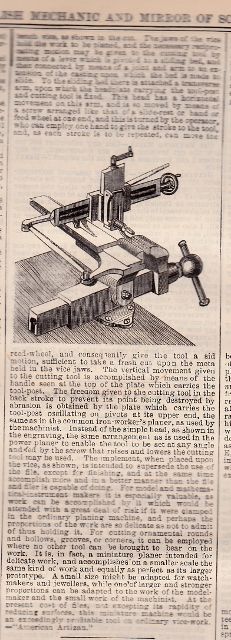Have been following this thread with interest – I had a motorised Adept No.2 shaper for about 20 years. Apparently not many were produced. It required quite a lot of work to bring it back to something like it’s original condition as previous owners had abused it., probably through not understanding it properly.
Very quiet in use, tool grinding very easy, using standard HSS blanks, and the ability to create “specials“ was handy. Probably saved me quite a lot of worn milling cutters over the years. Provided hours of amusement for the cat, who was fascinated by the chips flying through the air. A sheet metal tray was eventually fitted, which spoiled her fun.
Despite it‘s substantial construction, I felt that rigidity was a problem, and on longer strokes there was a tendency for the ram to lift slightly towards the end of the stroke, despite properly adjusted slides. This lift could be corrected by slight downward pressure on the ram. This might not be as apparent with the hand operated model, and most certainly not on larger industrial machines such as Boxford.
Adjusting the length of stroke and the start/finish points was quite a fiddle sometimes, and the auto cross feed needed careful adjustment and observation.
The occasional “dig in” of the tool could ruin a work piece and snap the tool, though generally belt slip saved the tool but not always the work piece.
An excellent surface finish was possible, with fine feed and really sharp, correctly ground and positioned tools, but could be very slow… a reasonable machine for sedate work progress.
The short series by John Olsen in ME in 2005 on cutting curves and cutting between centres on the shaping machine would be of interest I am sure. I recollect that the writer produced sets of expansion links, shaping both the external and internal profiles.
A very small hand shaper such as that envisaged by the OP would have been a great asset when I was making 0 and 1 gauge models 30+ years ago, and I can see the attraction of such a machine. I hope that this project succeeds, as I would be most interested to see the result.
The miller v. shaper discussion in Model Engineering circles has cropped up fairly regularly for at least 25 years in my experience, and no doubt will continue, but such discussion often leads to new useful information from the users of both types of machine. Even if the shaper is considered obsolete in industry, it is apparent that it has a useful life in the amateur area. It is not a substitute for a milling machine, but if one has the space and cash then it can be a useful and interesting additional machine.
As a final comment, my late father, a professional engineer, talking about his RAF service in North Africa during WW2, explained that the destruction of his mobile workshops in an air raid was not the disaster it seemed, as “we were re-equipped PDQ with decent modern American machine tools and reliable generators, no more “new” lathes of antiquated design, and no b***** hand shapers ”
Dave
John McNamara.






